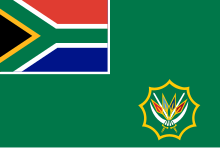
Back Suid-Afrikaanse Nasionale Weermag AF القوات الدفاعية الوطنية الجنوب إفريقية Arabic Cənubi Afrika Milli müdafiə qüvvələri AZ South African National Defence Force German Fuerza de Defensa Nacional de Sudáfrica Spanish نیروی دفاع ملی آفریقای جنوبی FA Etelä-Afrikan kansalliset puolustusvoimat Finnish Force de défense nationale sud-africaine French כוחות ההגנה של דרום אפריקה HE Dél-Afrika hadereje Hungarian
| South African National Defence Force | |
|---|---|
10 other official names:
| |
 Emblem of the SANDF | |
 Flag of the SANDF | |
| Motto | For the brave, for the proud |
| Founded | 1 July 1912 (112 years, 6 months) (as Union Defence Force) |
| Current form | 1994 |
| Service branches | South African Military Health Service |
| Headquarters | Pretoria, Gauteng, South Africa |
| Website | dod.mil.za |
| Leadership | |
| Commander-in-chief | President Cyril Ramaphosa |
| Minister of Defence and Military Veterans | Angie Motshekga |
| Chief of the SANDF | General Rudzani Maphwanya |
| Personnel | |
| Military age | 18–49 |
| Conscription | No (abolished in 1994) [1] |
| Available for military service | 10,354,769 males, age 18–49 (2005), 10,626,550 females, age 18–49 (2005) |
| Fit for military service | 4,927,757 males, age 18–49 (2005), 4,609,071 females, age 18–49 (2005) |
| Reaching military age annually | 512,407 males (2005), 506,078 females (2005) |
| Active personnel | 71,235 (2021/22)[2][3]: 108 |
| Reserve personnel | 29,350 (2020/2021)[4] |
| Expenditure | |
| Budget | US$2.8 billion[5] |
| Percent of GDP | 0.7% (2023) |
| Industry | |
| Domestic suppliers | |
| Foreign suppliers | |
| Related articles | |
| History | |
| Ranks | South African military ranks |
The South African National Defence Force (SANDF) comprises the armed forces of South Africa. The Chief of the SANDF is appointed by the President of South Africa from one of the armed services. They are in turn accountable to the Minister of Defence and Military Veterans of the Defence Department.
The military as it exists today was created in 1994,[6][7] following South Africa's first nonracial election in April of that year and the adoption of a new constitution. It replaced the South African Defence Force and also integrated uMkhonto we Sizwe (MK), and the Azanian People's Liberation Army (APLA) guerilla forces.
- ^ "Country report and updates". 7 March 2024.
- ^ Helfrich, Kim (25 October 2021). "SANDF by the numbers". defenceWeb. Retrieved 5 May 2023.
- ^ Department of Defence. Department of Defence Annual Report FY 2021/22 (PDF). Retrieved 5 May 2023.
- ^ "South Africa: South African National Defence Force". DefenceWeb. 1 February 2013. Archived from the original on 21 October 2014. Retrieved 21 October 2014.
- ^ Martin, Guy (5 May 2021). "SA defence budget falling to only .86% of GDP". defenceWeb. Retrieved 26 March 2023.
- ^ "Constitution of the Republic of South Africa Act 200 of 1993 (Section 224)". South African Government. 1993. Archived from the original on 12 June 2008. Retrieved 23 June 2008.
- ^ L B van Stade (1997). "Rationalisation in the SANDF: The Next Challenge". Institute for Security Studies. Archived from the original on 16 March 2016. Retrieved 23 June 2008.